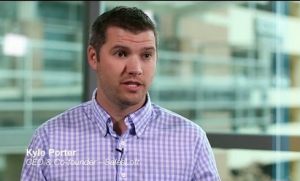By: Kyle Porter, CEO of SalesLoft
 In Inbound vs Outbound Sales, Jason emphasized the majority of the world gets exposed to their vendors….not the other way around. For modern businesses, vendor outreach is accomplished via a sales development team. And while the fundamentals have been around forever, the concept of sales development team is so new that there are not many established industry best practices.
In Inbound vs Outbound Sales, Jason emphasized the majority of the world gets exposed to their vendors….not the other way around. For modern businesses, vendor outreach is accomplished via a sales development team. And while the fundamentals have been around forever, the concept of sales development team is so new that there are not many established industry best practices.
Let’s establish your own sales development game-plan so that you can start turning hundreds of prospects into qualified appointments.
Set Your Communication Rhythm
Start by defining the number of prospects each of your reps is going to reach out to on a daily basis. For the most personalized outreach strategies, you may go as low as 20/day, but commonly this number should be around 40-60 new prospects/rep/day.
Next, determine the amount of phone calls, emails, and possibly social drips you want to apply. We call this mix your “Cadence.” A popular method is the 7×7 strategy:

Humorous email day 5, breakup email day 7
Just select a process and start with it. Over time, you’ll establish the best rhythm for your business.
Determine Your Ideal Buyer (right title, right company)
The ideal customer profile can be established by identifying the company size, industry, region, individual title, technology landscape, and pains, problems and challenges that make these companies a fit for your product.
The most effective way to determine these characteristics is to export a list of the closed won opportunities from your CRM, complete the demographics, and then rank them.
Define Qualification Criteria
Follow the ANUM qualification method:
- Authority
- Need
- Urgency
- Timing
Only the A&N (authority and need) are the responsibilities of your sales development team. You can leave U&M (urgency and money) to your closers.
Plan Goals For The Week, Month, and Quarter
Let’s say each rep is contacting 50 people per day (about 250 per week), we recommend setting a goal for the number of “interactions” (replies and connects) and the number of “turnovers” (qualified appointments or demos). At SalesLoft, we target 50 unique interactions each week and 10 turnovers.
Build A List and Go Find Them!
Avoid building prospecting lists with stale legacy data providers. The information is too noisy and inaccurate due to the ever-changing employee landscape.
Instead, look to Google, LinkedIn, Crunchbase, and other fresh (individually updated) sites to help guide the process.

We built SalesLoft Prospector to be the simplest way on the internet to extract prospects from professional social networks, enrich with phone numbers and emails, and sync to CRM.
Pro Tip: The browser is your friend. Become comfortable using social networks, boolean searches, and Chrome extensions.
Use a Communication Tool that Makes Calls and Sends Emails
You need a single place to be able to execute your process. One where you can build your rhythm, and deploy it to your team. It should allow you to send email templates and then quickly pop on your headset to power-dial a list.
The email component of the tool should include these 10 characteristics.
It should not only reduce manual labor with tracking features and templates, but also have the functionality to send 1-to-1 emails directly from your email sent folder, not a third party transactional server that will show up as spam.
SalesLoft Cadence allows you to do just that:

Create Your Email Templates
Make sure they are short, sweet, and to the point. Inject humor and colloquialisms…and don’t be afraid to ask for referrals.
You can find the outlines for every email SalesLoft sends in our recently released internal Sales Development Playbook.
Build Out Your Conversational Script
As you begin to cold call prospects, prepare scripted options for various scenarios that may arise.
You need to be prepared when you get a prospect on the phone, reach a gatekeeper, or go straight to voicemail. Plan and document these scripts in your playbook so that new reps will have a solid foundation from day one. Try introducing different strategies to see what works best in your phone and email conversations, like Jeff Hoffman’s “Why You, Why You Now,” strategy.
As reps grow more comfortable with the product and confident in themselves, they will be able to develop their own personality and drive every conversation.
Execute
Send your first email batch and follow up with phone calls in the afternoon. Don’t expect your inbox to be flooded with responses. An effective sales development process is a marathon not a sprint.
If you stick to your new sales development process and and keep up with your cadence, you’ll be able to maximize the number of prospects you convert, ultimately driving the growth you need to build a business that SaaStr himself would want to invest in!
About Salesloft
SalesLoft offers its clients the simplest way on the internet to build accurate lists of prospects and convert them to qualified appointments and demonstrations. SalesLoft’s Prospector product automates list building through the power of social networks and syncs contact information directly to existing CRM systems, while the Cadence application allows sales development teams to build and execute their own unique processes of sales development emails, phone calls and social drips.
Learn more at salesloft.com or by following SalesLoft on Twitter and LinkedIn.

